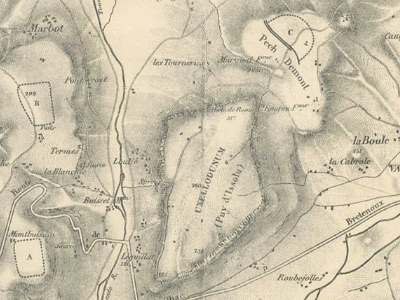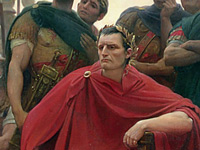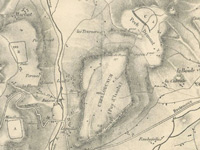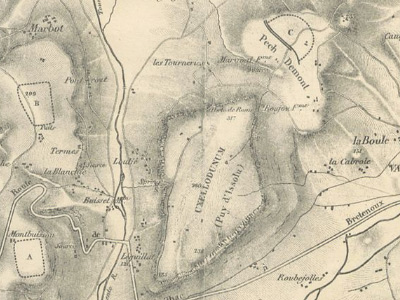Siege of Uxellodunum (51 BC)

The Siege of Uxellodunum was one of the last battles of the Gallic Wars. It took place in 51 BC at Uxellodunum. It was the last major military confrontation of the Gallic Wars and marked the pacification of Gaul under Roman rule. The battle resulted in a decisive Roman victory.
Actions Leading up to the Siege
Lucterius, the chief of the Carduci, and Drapes, chief of the Senones, had retired to the hill fort of Uxellodunum to remain in the relative safety of the fortifications until the governorship of Gaius Julius Caesar Julius Caesar (100-44 BC), was a Roman politician and general who played a critical role in the events that led to the demise of the Roman Republic and the rise of the Roman Empire. Caesar is considered by many historians to be one of the greatest military commanders in history. Julius Caesar » ended in Gaul. The group had apparently planned to then begin a new rebellion against their Roman conquerors. Uxellodunum was heavily fortified both by its natural position (a river almost entirely surrounded the hill upon which it was built) and by its impressive fortifications built by the Carduci tribe. Additionally, one side of the fort was protected by a mountainside which prevented any approach from that direction. For these reasons, it was impossible to besiege it in the same manner the Romans had used at the Battle of Alesia a year before.
Julius Caesar (100-44 BC), was a Roman politician and general who played a critical role in the events that led to the demise of the Roman Republic and the rise of the Roman Empire. Caesar is considered by many historians to be one of the greatest military commanders in history. Julius Caesar » ended in Gaul. The group had apparently planned to then begin a new rebellion against their Roman conquerors. Uxellodunum was heavily fortified both by its natural position (a river almost entirely surrounded the hill upon which it was built) and by its impressive fortifications built by the Carduci tribe. Additionally, one side of the fort was protected by a mountainside which prevented any approach from that direction. For these reasons, it was impossible to besiege it in the same manner the Romans had used at the Battle of Alesia a year before.
The Legatus in charge of Uxellodunum, Gaius Caninius Rebilus, conscious that his two legions were anxious to commence an action to repeat the glories Julius Caesar had won at Alesia, divided his legions into three camps in areas around the fort where the terrain was high enough to ensure that any attempt by the Gauls to escape the fort would likely be unsuccessful. By this manner, he planned to effectively seal off the city.
Gallic Blunders
The Gauls trapped inside the oppidum (the term for hill fort settlements such as Uxellodunum), having learned the lessons of starvation from the disaster at the Siege of Alesia (where Luciterius had been present), made plans to leave the settlement by night to forage for food and provisions. Climbing over the ramparts, Luciterius and Drapes left a garrison of around 2,000 men inside Uxellodunum, taking the remainder of their force to forage en masse. Some of the local Carduci Gauls in the surrounding areas freely gave the rebels supplies, but much of the provisions were taken by force. The Gauls then tried to again sneak past the Roman sentries set by Caninius Rebilus, but were spotted. Caninius Rebilus, upon learning of the Gauls' plans, concentrated the bulk of his legions and unleashed them on the Gaulish convoy. Luciterius, who was in charge of the convoy, immediately took flight with his war-bands without informing Drapes. The rest of the Gauls were massacred almost to a man, some sources saying that as many as 12,000 Gauls killed in the action.
Caninius Rebilus left one of his legions behind to defend his three camps and gathered the rest of his soldiers to pursue Drapes. He destroyed the remaining Gaulish forces in the area under Drapes (Luciterius having already fled), capturing Drapes, who was executed shortly thereafter.
Safe in the knowledge that further Gallic reinforcements would not likely be coming to the aid of Uxellodunum due to the blunders of Luciterus and Drapes, Gaius Caninius Rebilus intensified his siege works around Uxellodunum. Shortly after, Gaius Fabius, another of Caesar's legates in Gaul who had been tasked with subduing the Senones, arrived fresh from his victory at the Battle of the Loire with a full 25 cohorts of legions (roughly two and a half legions). These reinforcements put the Roman forces at four and a half legions, enough to construct competent siege works and completely encircle the fort.
Arrival of Gaius Julius Caesar and the cutting of the Water Supply
While these actions had been ongoing, Gaius Julius Caesar was in the territory of the Belgae in Gaul. There he was informed by courier of the revolt of the Carduci and Senones. Determined to ensure that there would be no more rebellions in Gaul after the expiration of his tenure as governor, Caesar set out immediately for Uxellodunum with his cavalry, leaving behind his legions, even though his two legates had the situation under control. Indeed, Caesar made his way so quickly to Uxellodunum that he surprised his two legates.
Caesar decided that the city could not be carried by force. This was a problem for the Romans because they had also been told by deserters that the city had an abundant food supply, despite the previous blunders of Luciterius and Drapes. Caesar decided therefore to target the city's water supply. The terrain of the fort was such that it would be impossible to divert the river anywhere near Uxellodunum, as the water flowed almost directly from the mountain down into the valley, making digging diversion canals infeasible. Caesar, however, noticed the difficulty the Gauls had collecting the water, having to come down a very steep slope to reach the riverbank. Exploiting this potential flaw in the defences, Caesar stationed archers and balista near the river to cover any attempt to gather water from this main source.
More troublesome for Caesar however, a secondary water source flowed down from the mountain directly underneath the walls of the fort. It seemed to be almost impossible to block access to this second source. The terrain was extremely rugged and it would not have been feasible to take the ground by force. Before long, Caesar was informed of the location of the source of the spring. With this knowledge, he ordered his engineers to build a ramp of earth and rock that could support a ten-story siege tower, which he used to bombard the spring source. Concurrently, he had another group of engineers build a tunnel system that finished at the source of the same spring.
The Battle
The Gauls, falling for the diversion of the tower, attacked it immediately, setting it on fire and keeping it under a constant barrage of missiles to prevent the Romans from extinguishing the fire. Caesar then sent a diversionary attack up the ramp, the narrowness of the works ensuring a bloody confrontation. After a good deal of fighting on the ramp, Caesar ordered his legions in positions surrounding the city to take up a war shout, fooling the Gauls into believing a direct assault on the walls was forthcoming. The Gauls were obliged to retire from their attacks and to man the walls.
Shortly thereafter, the sappers tunnelled through to the water source and finished the job of cutting the Gauls off from their water sources, forcing the Gauls to surrender their unfavourable position.
Aftermath and Reprisals
Caesar accepted the Gallic surrender. However he decided to ensure that this would mark the last Gaulish rebellion by setting a severe example. He decided against executing or selling the survivors into slavery, as had been customary in contemporary battles. Instead, he had the hands of all the surviving men of military age cut off, but left them alive. He then dispersed the vanquished Gauls throughout the province for all to see that they would never again be able to take up arms against him or the Roman Republic The Roman Republic was a form of government of Rome and the era of the classical Roman civilization when it was run through public representation of the Roman people. Beginning with the overthrow of the Roman Kingdom (traditionally dated to 509 BC) and ending in 27 BC with the establishment of the Roman Empire, Rome's control rapidly expanded during this period - from the city's immediate surroundings to hegemony over the entire Mediterranean world..
The Roman Republic was a form of government of Rome and the era of the classical Roman civilization when it was run through public representation of the Roman people. Beginning with the overthrow of the Roman Kingdom (traditionally dated to 509 BC) and ending in 27 BC with the establishment of the Roman Empire, Rome's control rapidly expanded during this period - from the city's immediate surroundings to hegemony over the entire Mediterranean world..
After dealing with the Gaulish rebels, Caesar took two of the legions and marched to summer in Aquitania which he had previously not visited. He briefly passed through the city of Narbo Martius in the Roman province of Gallia Narbonensis and marched through Nementocenna. Deeming Gaul sufficiently pacified, as no further rebellions arose, Caesar took the 13th Legion and marched to Italy, where he proceeded to cross the Rubicon and start the Great Roman Civil War on 17 December 50 BC.
HISTORY

RESOURCES
This article uses material from the Wikipedia article "Siege of Uxellodunum (51 BC)", which is released under the Creative Commons Attribution-Share-Alike License 3.0.
© Stories Preschool. All Rights Reserved.









